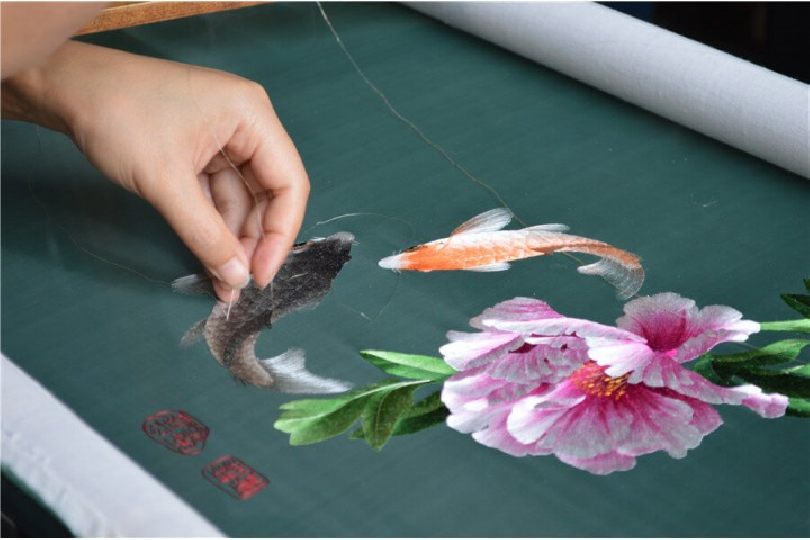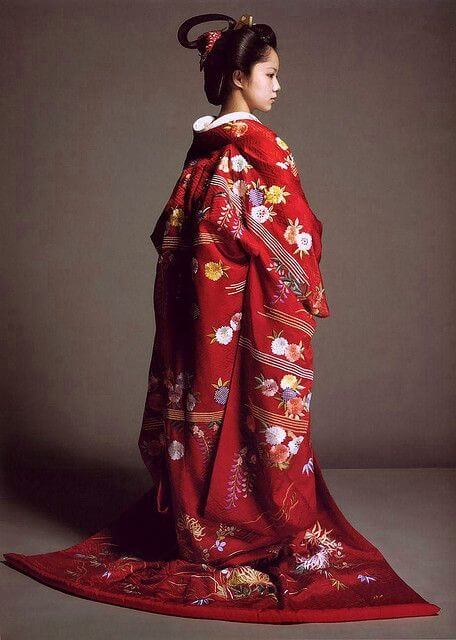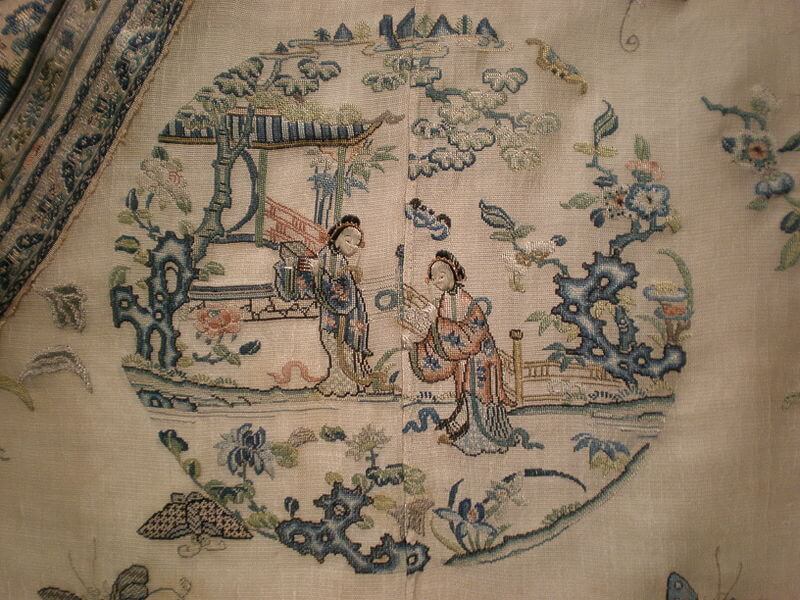Embroidery of the Far East and Asia

The ancient culture of Far Eastern people still exists, since modern women of fashion adore wearing traditional national embroidered shirts. Delightful colourful threads, exquisite patterns and quality fabrics capture them straightway.
Chinese embroidery

Embroidery is one of the oldest crafts in the world. Chinese silk embroidery has a two-thousand-years history. Chinese embroidery is elegant, stylish, refined and bright. A natural glitter of threads makes them shine. Most Chinese craftswomen managed to represent various images of flowers, birds, landscapes and epic heroes on fabric.
Traditional Chinese embroidery originated from the town of Suzhou located in the south of China. Soon that small town even got an honourable name of “Capital of vyshyvanka”. At the beginning of the 14th century, Suzhou became a major silk production centre. Almost every family had its own embroidery secrets and artfully embroidered fabrics. Moreover, almost every family was engaged in breeding pine caterpillars and could produce high quality threads and fabrics. It is quite natural that Chinese craftswomen cherished their secrets as the apple of their eyes.
Chinese embroidery is a unique work of art, as the embroidery technique seems to allow them to draw a real picture with silk. Such painstaking work gives birth to incredibly elegant and beautiful embroidered dresses. The main feature of Chinese embroidery is the technique of covering large parts of a pattern with stitches of different length.
The principles and skills of embroidery have almost unchanged for thousands of years. Since her childhood, a girl is taught by her loving mother to keep a needle in hands, to carefully choose threads, and to embroider various patterns – in a word, to create!
Japanese embroidery

While traveling the countries of the Far East, we can get to one of the most mysterious places in the world – Japan, where the art of embroidery has a long history. Here the popularity of embroidered clothes flourished in the 17th century. Despite the fact that Japan is an island country, its traditions were established in accordance to the world fashion trends. Bright embroidered clothes were available only to wealthy upper class people, the members of the imperial court, and rich merchants.
The main feature of Japanese embroidery is the use of many layers. Japanese craftswomen used to put together several cloths, to stitch them, and then to pattern. It is worth noting that the Japanese known for their subtle taste in everything paid and are still paying much attention to the symbols embroidered on fabric. It is impossible to imagine a Japanese woman who would not know the symbolic meaning of the patterns embroidered on her kimono. As a rule, the Japanese prefer plant and animal patterns featuring brightness, exquisiteness, aesthetics and meaningfulness.
Geometric patterns that conditionally represent flowers’ blooming, the movement of birds’ wings and the sprouting of delicate grass shoots symbolize the continuity of life and the power of nature.
Traditional and modern Japanese dresses are embroidered with cotton and silk threads, using various stitching techniques. Women of fashion prefer dresses embroidered in satin stitch using silk threads on silk fabric that look awfully festive and elegant.
Production and wearing of embroidered clothes by Far Eastern nations is an extremely good and centuries-long tradition. It continues gaining popularity and developing, acquiring new meanings and symbols.

The ancient culture of Far Eastern people still exists, since modern women of fashion adore wearing traditional national embroidered shirts. Delightful colourful threads, exquisite patterns and quality fabrics capture them straightway.
Chinese embroidery

Embroidery is one of the oldest crafts in the world. Chinese silk embroidery has a two-thousand-years history. Chinese embroidery is elegant, stylish, refined and bright. A natural glitter of threads makes them shine. Most Chinese craftswomen managed to represent various images of flowers, birds, landscapes and epic heroes on fabric.
Traditional Chinese embroidery originated from the town of Suzhou located in the south of China. Soon that small town even got an honourable name of “Capital of vyshyvanka”. At the beginning of the 14th century, Suzhou became a major silk production centre. Almost every family had its own embroidery secrets and artfully embroidered fabrics. Moreover, almost every family was engaged in breeding pine caterpillars and could produce high quality threads and fabrics. It is quite natural that Chinese craftswomen cherished their secrets as the apple of their eyes.
Chinese embroidery is a unique work of art, as the embroidery technique seems to allow them to draw a real picture with silk. Such painstaking work gives birth to incredibly elegant and beautiful embroidered dresses. The main feature of Chinese embroidery is the technique of covering large parts of a pattern with stitches of different length.
The principles and skills of embroidery have almost unchanged for thousands of years. Since her childhood, a girl is taught by her loving mother to keep a needle in hands, to carefully choose threads, and to embroider various patterns – in a word, to create!
Japanese embroidery

While traveling the countries of the Far East, we can get to one of the most mysterious places in the world – Japan, where the art of embroidery has a long history. Here the popularity of embroidered clothes flourished in the 17th century. Despite the fact that Japan is an island country, its traditions were established in accordance to the world fashion trends. Bright embroidered clothes were available only to wealthy upper class people, the members of the imperial court, and rich merchants.
The main feature of Japanese embroidery is the use of many layers. Japanese craftswomen used to put together several cloths, to stitch them, and then to pattern. It is worth noting that the Japanese known for their subtle taste in everything paid and are still paying much attention to the symbols embroidered on fabric. It is impossible to imagine a Japanese woman who would not know the symbolic meaning of the patterns embroidered on her kimono. As a rule, the Japanese prefer plant and animal patterns featuring brightness, exquisiteness, aesthetics and meaningfulness.
Geometric patterns that conditionally represent flowers’ blooming, the movement of birds’ wings and the sprouting of delicate grass shoots symbolize the continuity of life and the power of nature.
Traditional and modern Japanese dresses are embroidered with cotton and silk threads, using various stitching techniques. Women of fashion prefer dresses embroidered in satin stitch using silk threads on silk fabric that look awfully festive and elegant.
Production and wearing of embroidered clothes by Far Eastern nations is an extremely good and centuries-long tradition. It continues gaining popularity and developing, acquiring new meanings and symbols.


Comments
No comment at this time!
Leave your comment